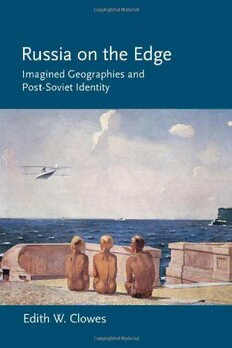
Russia on the Edge: Imagined Geographies and Post-Soviet Identity PDF
Preview Russia on the Edge: Imagined Geographies and Post-Soviet Identity
RUSSIA ON THE EDGE RUSSIA ON THE EDGE Imagined Geographies and Post-Soviet Identity EDITH W. CLOWES Cornell University Press ithaca and london Copyright © 2011 by Cornell University All rights reserved. Except for brief quotations in a review, this book, or parts thereof, must not be reproduced in any form without permission in writing from the publisher. For information, address Cornell University Press, Sage House, 512 East State Street, Ithaca, New York 14850. First published 2011 by Cornell University Press First printing, Cornell Paperbacks, 2011 Printed in the United States of America Library of Congress Cataloging-in-Publication Data Clowes, Edith W. Russia on the edge: imagined geographies and post-Soviet identity / Edith W. Clowes. p. cm. Includes bibliographical references and index. ISBN 978-0-8014-4856-0 (cloth : alk. paper) ISBN 978-0-8014-7725-6 (pbk. : alk. paper) 1. Russian literature—21st century—History and criticism. 2. Russian literature— 20th century—History and criticism. 3. National characteristics, Russian, in literature. 4. Nationalism and literature—Russia (Federation) 5. Cultural geography—Russia (Federation) 6. Territory, National—Russia (Federation) 7. Russia (Federation)— Intellectual life—1991– I. Title. PG3027.C57 2011 891.709'35847—dc22 2010042040 Cornell University Press strives to use environmentally responsible suppliers and materials to the fullest extent possible in the publishing of its books. Such materials include vegetable-based, low-VOC inks and acid-free papers that are recycled, totally chlorine-free, or partly composed of nonwood fi bers. For further information, visit our website at www.cornellpress.cornell.edu. Cloth printing 10 9 8 7 6 5 4 3 2 1 Paperback printing 10 9 8 7 6 5 4 3 2 1 CONTENTS Preface ix Abbreviations xvii Introduction: Is Russia a Center or a Periphery? 1 1 Deconstructing Imperial Moscow 19 2 Postmodernist Empire Meets Holy Rus': How Aleksandr Dugin Tried to Change the Eurasian Periphery into the Sacred Center of the World 43 3 Illusory Empire: Viktor Pelevin’s Parody of Neo-Eurasianism 68 4 Russia’s Deconstructionist Westernizer: Mikhail Ryklin’s “Larger Space of Europe” Confronts Holy Rus' 96 5 The Periphery and Its Narratives: Liudmila Ulitskaia’s Imagined South 120 6 Demonizing the Post-Soviet Other: The Chechens and the Muslim South 140 Conclusion 165 Index 173 0 1 0 2 a, si a r u E n r e h rt o N of p a M PREFACE I n January 1986, the new Borovitskaia Metro Station opened by the Kremlin wall in central Moscow. Built to remind the visitor of the low-arching hallways of the medieval Kremlin, the station’s visual centerpiece is a vast, gold and burnt orange mural depicting the map of the Soviet Union and its peoples growing as a tree among the towers of the Kremlin. Fifteen impassive human fi gures stand for the fi fteen Soviet republics. This image conveys an unconven- tional view of national identity, not as a grassroots formation out of which emerged a state. Rather, for the Soviets nationality was a plant cultivated, developed, and controlled by the state, symbolized here by the Kremlin. The year 1986 is best known for the nuclear disaster at Chernobyl. In the aftermath the Soviet state in the person of Mikhail Gorbachev gave the si- lent Soviet nationalities a voice, the right to probe and debate painful truths, past and present. With his policy of glasnost, or openness and transparency, Gorbachev hoped to reform and revive the multinational empire he ruled. Instead, he opened the way to a remarkable debate about identity and to the eventual dissolution of the Soviet Union. These two images—the mute nationalities on the tree-like Soviet map and people suddenly voicing their views, discussing and debating all over the Union—speak to the overwhelming power of the Russian-centered Soviet state to defi ne, to shape, and to bestow identity. Many would say that the center was hypertrophied, that it had too much power, and various nation- alities began to resist its infl uence. Russians, in turn, would push back, ques- tioning their own identity. With the dissolution of the Soviet Union in 1991 peripheries and borders, both real and symbolic, would become the keys to Russians’ thinking about who they are. This book investigates how and why these images became so central to Russian identity. n. o si s mi r e p h wit d e c u d o r p e r 7, 0 0 2 s, ri r a H M. e n n e ri d A y b o ot h p 6), 8 9 1 w ( o c s o M n, o ati St o r et M a ai k s vit o r o B n al i r u M 1. g. Fi
